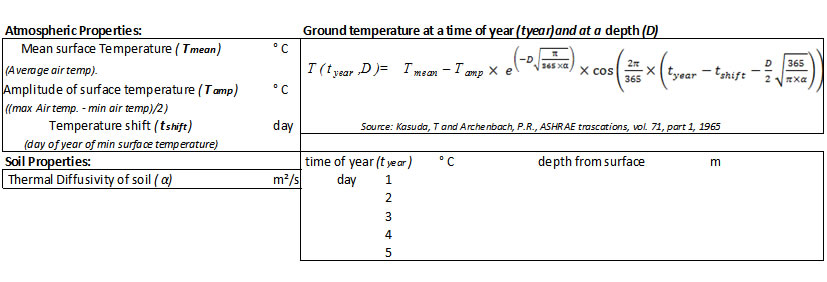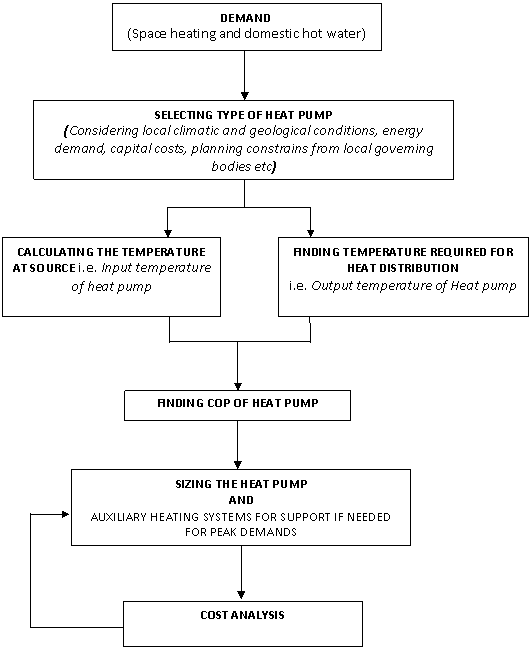

- General Considerations
- Specific Considerations

Heat Pump – Application for Space and Water Heating in Rural Locations
Heat pumps are a reliable and efficient technology for space heating, cooling and water heating purposes. In rural locations the availability and accessibility of sources are higher, making heat pumps a primary choice for heating and cooling supply.
Following is the methodology for applying heat pumps for space and water heating purpose in rural locations:
Figure 1. Methodology for Applying Heat Pumps for heating in Rural locations
Demand:
Space heating demand is the amount of energy required to heat a space or maintain a desired temperature. Similarly, hot water demand is the amount of energy required to heat water. The methodology and tools for calculating the demands were explained in the section methodology for determining energy demand.
Selecting Heat Pump type:
Selecting the type of heat pump to be used mainly depends on what is to be done with it (heating, heating and cooling, etc.), the type of building (new, renovated) and its use (domestic, small and large commercial building, service sector, industrial or agriculture, etc). For detaiedl considerations of each and every heat pump type, check opportunity for heat pumps in rural locations.
Source temperature:
As we already know Heat pumps are devices that move heat from a low temperature source to a higher temperature heat sink in heating mode (and vice versa in cooling mode). So performance of the heat pumps mainly depends on the temperature at source. The smaller the variation of source temperature the greater the performance of heat pumps. Heat pumps are mainly classified based on type of source, explained in opportunity for heat pumps in rural locations section.
Finding the source temperature for Air Source Heat Pump (ASHP) is simple because it uses atmospheric air or extracted air as the heat source. Since Ground Source Heat Pumps (GSHP) use soil at various depths as the source of heat, finding temperature at depths over various periods of time is not simple as in the case of ASHP. At the surface, the heat gains and losses vary with the seasons: in winter the losses are higher and the gains lower than in summer. As a consequence, the surface temperature follows the air temperature. But below the surface, the ground stores energy, and reduces this variation. This dampening effect increases with depth
Table1. Annual Ground Temperature Distribution at Different Depths for GSHP

Source: Georgios Florides and Soteris Kalogirou, Annual Ground Temperature Measurement at various depths
The actual difference between the annual average air temperature and the ground temperature will depend on factors such as atmospheric temperatures, ground cover and vegetation, snow cover, slope, and soil properties. The temperature distribution at different depths over a period can be calculated using a correlation developed by KASUDA. This was found in ASHRAE publications shown above. Calculations were performed using this correlation for the case studies shown in later sections (developing a tool for calculating soil temperatures for different climatic and soil conditions).
Heat Distribution temperature:
The Heat distribution system supplies heat to the sink - different systems requires different temperatures to supply and maintain the temperature of sink. Distribution temperatures for different systems are shown below, and for heating water de-super heating is normally used. In heat pump terminology the difference between the temperatures where the heat is extracted “source” and the temperature where it distributed “sink” is called “Lift”.
Table 2. Delivery temperature for various distribution
Source: Heat pumps in residential and commercial buildings, www.heatpumpcentre.org
Finding COP of a heat pump:
The Coefficient of Performance (COP) is used to define the heating performance of heat pumps. COP is defined as the ratio of heat delivered by the heat pump and the electricity supplied to the heat pump to deliver the useful heat.
Table 3. COP for different types of Heat Pump for different lift temperature
Source: Canadian Standards Association, CAN/CSA-C13256, Natural Resources Canada’s (NRCan’s) Commercial Earth Energy Systems: A Buyer’s Guide.
The heating coefficient of performance of a heat pump mainly depends on the temperature lift i.e. temperature difference between the heat distribution and source. The COP of different heat pumps varying with lift are shown in the table above. These values adapted from Canadian Standards Association, Energy Efficiency Directory.
In the above table COP's for only rounded lift temperature numbers are shown. COP's at a lift temperature other than shown in the table can be found from the heat pump analysis tool.
Sizing the heat pump and auxiliary heating system:
Sizing a heat pump is very important in supplying energy to meet the demand. If the heat pump is designed under the demand an auxiliary heating system has to be installed to meet the total demand. If the heat pump is over designed, the capital cost of the project will be very high and pay back periods are increased.
But in the case of uneven seasonal or monthly demand, heat pumps have to be designed for base load and peak loads are to be supplied by other heating systems that keep the capital costs lower and pay back periods shorter.
Cost Analysis and environmental Impact:Cost analysis and environmental impact play a prominent role in sizing the heating system and studying the economic feasibility of the project. The cost analysis covers the estimation of the capital cost, operation and maintenance costs, running costs of the project and its savings over the current system. Finally, the payback time is calculated.
References:
- Ground source heat pump project analysis, RET Screen International.
http://retscreen.net/download.php/ang/479/0/Textbook_GSHP.pdf
- Commercial earth energy systems: A buyers guide, Natural Resources Canada.
http://canmetenergy-canmetenergie.nrcan-rncan.gc.ca/fichier.php/codectec/En/ISBN:0-662-87736-5/M92-251-2002E.pdf
- G Florides and S Kalogirou. Annual Ground Temperature Measurements at Various Depths, Higher Technical Institute, Cyprus.
http://ktisis.cut.ac.cy/bitstream/10488/844/1/C78-CLIMA2005.pdf
- Heat distribution systems, 2009. Heat Pumps in residential and commercial buildings. Available at: http://www.heatpumpcentre.org/About_heat_pumps/HP_buildings.asp
- Jean-Claude (2009), "Renewable Energy Technologies".
| MSc: Renewable Energy Systems and the Environment | © University of Strathclyde 2010 |


